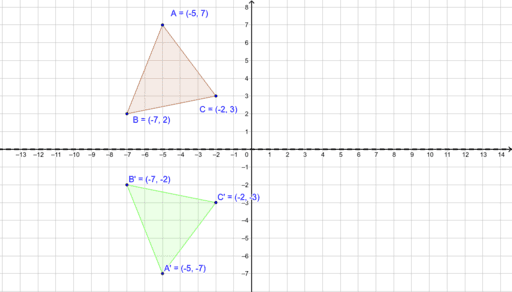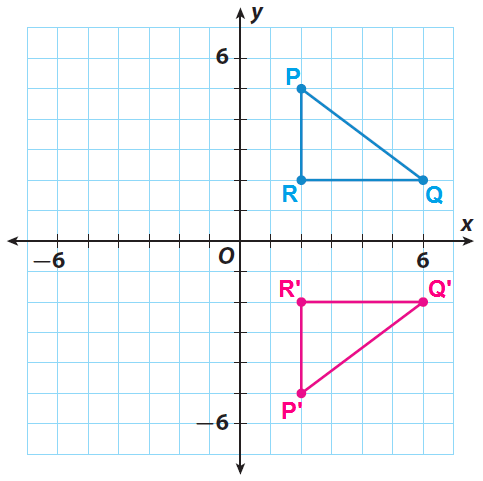

Just remember, any time you take a function and you replace its x with a -x, you reflect the graph around the y axis. The reflection of the point (x, y) across the x-axis is the point (x, -y). c units y f(x c), reflection in y-axis y f(x), reflection in x-axis y f(x). So as predicted, it's a reflection it's a reflection of our parent graph y equals 2 to the x. Equation forms of lines: Point-Slope: Slope-Intercept:, y mx b y x0 m(x x0). There are four types of transformations of functions or graphs: Reflection, Rotation, Translation and Dilation. For example, the reflection of the function y f ( x) can be written as y f ( x) or y f ( x) or even y f ( x). I have 1 comma one half, I have 0 1, so passes through this point and -1 2. The reflection of a function can be over the x-axis or y-axis, or even both axes. This video shows two methods of achieving this reflection. Now what about y equals 2 to the -x? Let me choose another colour. This video demonstrates the steps needed to reflect a figure over the y-axis. 1 one half, 0 1 and 1 2 and I've got my recognizable 2 to the x graph that looks like this. And so I'm just going to plot these two functions. But if -x=u then really I just have the 2 to the u values here so these values just get copied over. So -1 becomes 1, 0 stays the same and 1 becomes -1. So if I let u equal -x and x=-u and all I have to do is change the sign of these values. So those are nice and easy and then to make the transformation, I'm going to make the change of variables -x=u.

2 to the negative 1 is a half, 2 to the 0 is 1, 2 to the 1 is 2. I'm going to change variables to make it easier to transform and I'm going to pick easy values of u like -1 0 and 1 to evaluate 2 to the u. We call the y equals 2 to the x is one of our parent functions and has this shape sort of an upward sweeping curve passes through the point 0 1, and it's got a horizontal asymptote on the x axis y=0.

So I want to graph y equals 2 to the x and y equals y equals 2 to the -x together. Now to see this, let's graph the two of them together. This is a reflection of what parent function? Well it's y equals to the x right? This will be a reflection of y equals to the x. So let's consider an example y=2 to the negative x. If the negative sign belongs to the y, then the graph will flip about the x-axis. So you replace the x with minus x and that will reflect the graph across the y axis. Remember Reflections: They appear like opposites. But how do you reflect it across the y axis? Well instead of flipping the y values, you want to flip the x values. All you have to do is put a minus sign in front of the f of x right? Y=-f of x flips the graph across the x axis. Transformations Homework Packet Intro: Coordinate Plane Label the axes and origin reflection across the x-axis T(2.
Reflection over y axis how to#
Now recall how to reflect the graph y=f of x across the x axis. So in this case, what we now know is that negative F of X is a reflection over the X axis.Let's talk about reflections. So no, this this graph flips over the X axis. Reflections in the y-axis y f ( x ) + a translate up/down by the vector ( 0 a ) y f ( x + a ) translate left/right by the vector ( a 0 ) y. And if you multiply a positive value by a negative that will become negative. Well, if you were a negative value for Y at first, when you multiply by a negative will become positive. That means all of our why values are going to be the opposite sign. So let's say this is our Y equals F of X graph. Let, A(1, 5) be a point, and the line y x be the axis of reflection, the line y x is a line bisecting the angle between X-axis and Y-axis lying in the first. So in other words, if I had a graph, let's just say we had a linear equation. That means we would be taking all of our wide values and making it the opposite sign. Why? So because it's equal to negative Y. The area of the region enclosed by 4 x + 5 yls 20 is ( a ) 10 ( b ) 20 ( c ) 40 ( d ) none of these Solution ( d ) Reflection in the y - axis gives.

So if I go ahead and substitute why in place of F of X, that would give me negative. Remember that function notation and F of X is equal to why those are equivalent expressions. P P m Figure 7.1 When you are working in the coordinate plane, it's common to see reflections over one of the axes, or over the line y x. So in this problem you're being asked to determine if negative F of X is a reflection over the X or the Y axis.


 0 kommentar(er)
0 kommentar(er)
